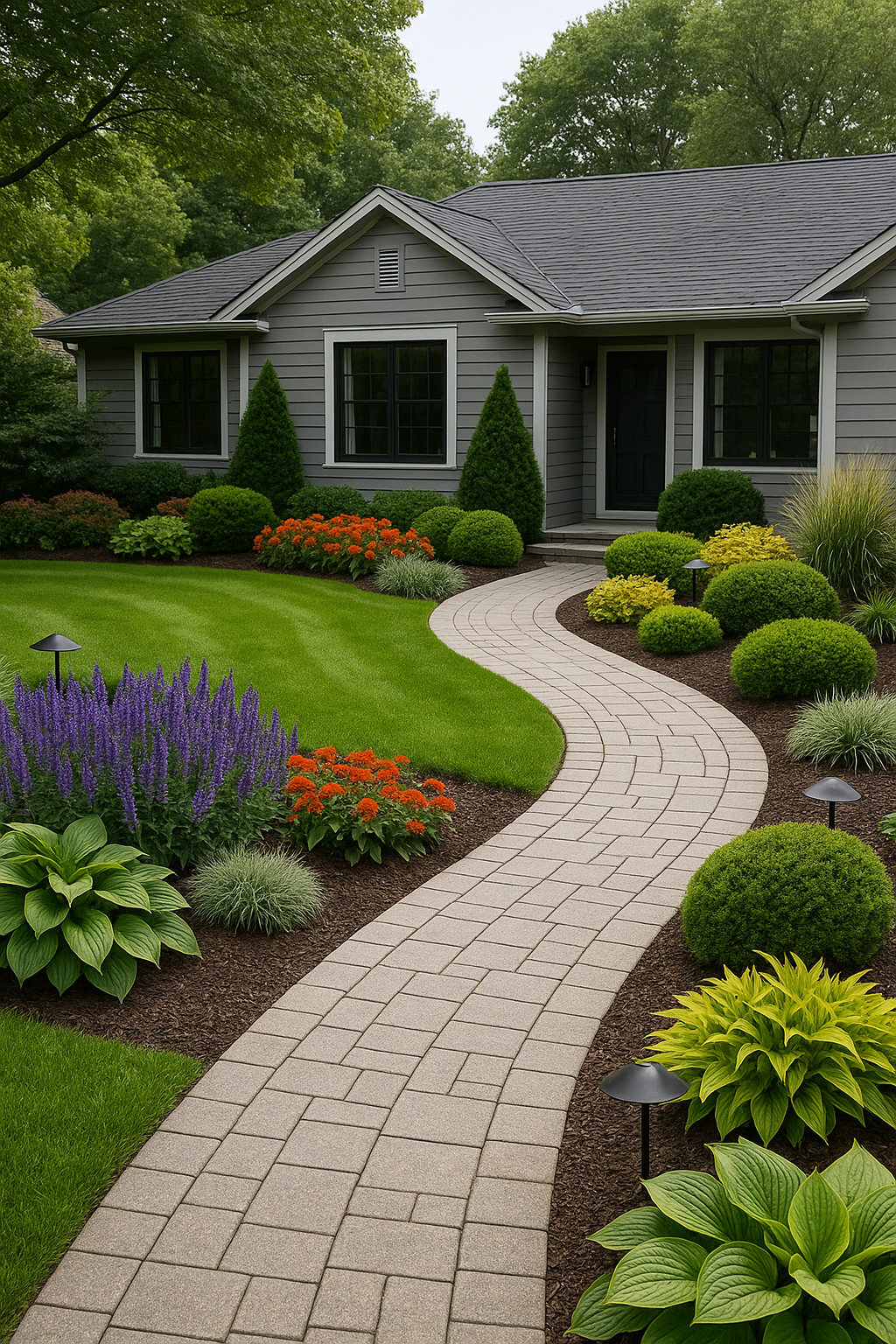This guide explores high-impact landscaping ideas, essential lawn care techniques, and time-tested garden design principles that elevate any outdoor space—residential or commercial.
1. Landscape Design Philosophy: Build With Intention
Professional landscaping starts with vision, not guesswork. The best landscapes aren’t crammed with plants—they’re orchestrated spaces that serve both purpose and beauty.
Key Questions to Ask:
How will the space be used? (Entertaining, relaxing, gardening, etc.)
What’s the climate and soil type?
Are there problem areas (drainage, slope, dead zones)?
What style fits your architecture? (Modern, rustic, traditional, xeriscaped)
Design Fundamentals:
Unity: Tie the landscape together using recurring forms or materials.
Balance: Symmetry for formal designs, asymmetry for natural flow.
Scale: Match plant size to the house and space.
Focal Points: Statues, specimen trees, or water features to draw attention.
2. Professional Landscaping Ideas That Transform
Even small yards can look professionally designed with the right strategy.
Front Yard Enhancements
Framing the Entryway: Use trees or structured shrubs to guide eyes to the front door.
Foundation Plantings: Layer shrubs, perennials, and groundcovers around the house’s base.
Hardscape Accents: Add paver walkways, stone edging, or landscape lighting to define space.
Backyard Upgrades
Outdoor Living Rooms: Include patios with seating zones, fire pits, and overhead pergolas.
Privacy Landscaping: Use hedges, tall grasses, or bamboo screens to block views.
Multi-Level Terracing: Ideal for sloped properties to manage erosion and maximize planting space.
Water Features
Install a modern fountain, koi pond, or stream to add movement and sound.
Surround water features with natural boulders and moisture-loving plants.
Low-Maintenance Landscaping
Incorporate evergreens, ornamental grasses, and native plants.
Use mulch and landscape fabric to suppress weeds and retain moisture.
3. Lawn Care That Reflects Professional Standards
A lush, healthy lawn is a defining feature of any great landscape—but only with proper care.
Lawn Types by Region
Cool-Season Grasses (e.g., Kentucky bluegrass, fescue): Thrive in northern climates.
Warm-Season Grasses (e.g., Bermuda, zoysia): Ideal for southern regions.
Shade-Tolerant Mixes: Use under trees or north-facing areas.
Seasonal Lawn Care Calendar
| Season | Tasks |
|---|---|
| Spring | Aerate, dethatch, fertilize, reseed |
| Summer | Water deeply, mow high, spot-treat weeds |
| Fall | Fertilize, overseed, leaf removal |
| Winter | Avoid heavy traffic, plan renovations |
Pro-Level Tips
Mow High: Cut grass to 3–3.5 inches for deeper roots and fewer weeds.
Sharpen Mower Blades: Clean cuts reduce disease risk.
Irrigation: Deep watering 2–3 times/week is better than daily sprinkles.
Soil Testing: Use annually to correct pH and nutrient imbalances.
4. Garden Design Principles for Cohesion and Impact
Whether you’re creating a cutting garden, herb spiral, or mixed perennial border, applying proper design principles ensures results that look curated, not chaotic.
Color Theory in Garden Beds
Monochromatic: One color in varying shades—elegant and calming.
Analogous: Colors next to each other on the wheel (e.g., yellow, orange, red).
Complementary: Opposites like blue and orange—create dynamic contrast.
Plant Layering
Vertical Layers: Tall shrubs/trees at the back, medium perennials in the middle, low groundcovers in front.
Seasonal Layers: Combine early, mid, and late bloomers for continuous color.
Texture and Form
Mix fine and coarse foliage for contrast.
Use vertical elements (ornamental grasses, hollyhocks) with mounded plants (lavender, peonies).
5. Smart Hardscaping Ideas
Hardscapes create structure, define zones, and add permanence.
Patios and Paths
Materials: Flagstone, concrete pavers, gravel, decomposed granite.
Edging: Steel, stone, or brick creates clean separation.
Retaining Walls and Raised Beds
Build with stone, timber, or concrete blocks.
Use for visual interest or to manage elevation changes.
Outdoor Lighting
Path lights for safety.
Uplighting trees for drama.
String lights or wall sconces for ambiance.
6. Sustainable and Eco-Conscious Landscaping
Sustainability in landscaping is not optional anymore—it’s responsible and forward-thinking.
Native Plants: Require less water, fertilization, and pesticides.
Rain Gardens: Capture runoff and filter pollutants.
Permeable Pavers: Let water soak through, reducing erosion.
Compost and Mulch: Enrich soil and reduce waste.
Drip Irrigation: Delivers water directly to roots with less evaporation.
7. Working With Landscape Professionals
If you’re planning a large project or lack time, hiring a pro is worth the cost.
What to Look For:
Certifications (e.g., ICPI for paver installers, ISA for arborists)
Portfolio of past work
Strong reviews and references
Knowledge of local conditions and native plant species
Design-Build vs. Full-Service Landscaping
Design-Build: One company handles the whole project.
Full-Service: Includes maintenance plans post-installation.
8. Landscape Maintenance Checklist
| Weekly | Monthly | Seasonally |
|---|---|---|
| Mow lawn | Trim hedges | Prune trees and shrubs |
| Weed beds | Clean hardscapes | Refresh mulch |
| Inspect irrigation | Deadhead perennials | Apply fertilizer |
| Edge lawns | Check for pests | Plant or divide perennials |
Automation tools (robot mowers, smart irrigation) can reduce manual labor dramatically.
9. Design Trends in 2025 and Beyond
Meadow Gardens: Less mowing, more wildflowers.
Black Accents: Matte black fences, planters, and trim.
Outdoor Rooms: Fully-furnished patios with heating, kitchens, and media.
Climate-Adaptive Design: Landscapes built for droughts or excess rain.
Foodscaping: Mixing edibles like herbs, kale, or tomatoes with ornamental beds.
10. Conclusion: Landscape With Purpose
A truly professional landscape looks effortless—but only because it's rooted in expertise, planning, and care. It's not about spending the most, but designing with intention, maintaining with consistency, and choosing plants and features that serve your lifestyle.
From soil to skyline, every detail matters. Make your outdoor space an extension of your home—functional, sustainable, and beautiful year-round.
